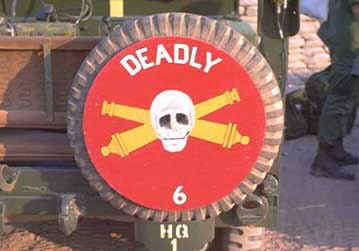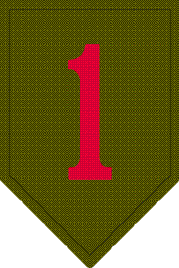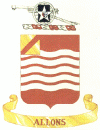6/15th
History - Vietnam
War
15th
Field Artillery Regiment
INDIANHEADS
6th
Battalion, 15th Field Artillery
"DEADLY"
Vietnam War
Written
by: Brigadier General Frank E. Serio (Ret)
Submitted by: Keith Solomon

The 6/15 Artillery departed Fort Sill 1 May 1967 for Vietnam. An advanced party of 13 officers, 8 NCO's and 2 enlisted men departed Fort Sill by air on 15 May and arrived at Ben Hoa on 17 May 1967. On 26 May the main body of the battalion arrived by ship at the port of Vung Tau and moved directly by air the following day to Lai Khe. Equipment arrived at Lai Khe 4 days later by road. By Division policy, the battalion had to select a radio call sign beginning with the letter "D". The 6/15th Artillery chose "DEADLY" as its call sign. Its permanent base camp was established at Lai Khe with Headquarters, Service and C batteries. Battery B went to Phouc Vinh and battery A to Phu Loi.
The original mission for the 6/15th to be permanent base camp fire support was changed and it was now to provide direct support to infantry units on deployed operations. General Depuy's assignment of all 4.2 inch mortars in the Division to the Division Artillery permitted this change, this change in mission permitted "DEADLY" batteries to begin combat operations 30 June 1967. However, DEADLY personnel were in combat during the Battle of XOM BO II on 17 June 1967. Captain Joe Piram, artillery liaison officer from DEADLY to the 1/16 Infantry, and some forward observers accompanied the 1/16 Infantry on an operation east of Quan Loi. While this was happening, main units of the battalion were going through their final training and in-country indoctrination.
The first combat mission assigned the 6/15 was to establish a fire support base at the Dutchman’s, an open area west of Chon Thanh, to support operations of 2/28 Infantry. This was a real learning experience for everyone from the battalion commander to the junior private. DEADLY (minus Batteries A and B) with a platoon of 155 mm howitzers from 8/6 Artillery accompanied for perimeter defense by an infantry company from 2/28 Infantry and a cavalry troop moved North on Route 13 to Dutchman's.
DEADLY was still at the Dutchman fire support base on 4 July. In accordance with Division Artillery instructions, 50 rounds were to be fired, one for each State in the union starting at noon that day. Just before noon a Chinook helicopter landed outside the perimeter to quote one of DEADLY's soldiers, Philip Jones, in a book written years later, "You can imagine our surprise when the tailgate of this huge machine opened up and out marched the Division Band. Honest to God! Trombones, trumpets, tubas—a thirty piece marching band right here in the middle of the boonies. We cheered like crazy men! If any VC had been watching I'm sure that they were totally demoralized by this flagrant display of patriotism." That was DEADLY's Fourth of July 1967 in Viet Nam.
About the 15th of July, DEADLY moved to Quan Loi just east of An Loc. The Division had received intelligence that VC and NVA units were moving into the area. DEADLY's tactical command post (TAC CP), plus Battery C were positioned on the west side of the air strip at Quan Loi. The airstrip was on the top of a small hill and presented an excellent target for an occasional mortar and rocket fire. Just to be certain that the VC could find us, the airstrip had a hundred foot communications tower with red lights to help the VC gunners. One of DEADLY's enterprising soldiers shot out the lights one night as the VC mortars started firing.
Protection of the airstrip and small base camp at Quan Loi was provided by an infantry company of the 3rd Brigade, a platoon from the 1-4 Armored Cavalry and Battery C, 6/15 Artillery. On the night of 11 July, while Battery C was providing fire support for an Army of the Republic of Vietnam compound located five miles away, the base camp and Battery came under a combined VC mortar, rocket and ground attack. While continuing to provide fire support for the ARVN Compound, the Battery Commander, Captain Mark Haselton, directed one-half of the Battery to provide it's pre-planned final protective fire. That night Battery C received its baptism under enemy fire and in the process fired more than two thousand 105 mm rounds of ammunition and stopped the VC attack.
By 30 September 1967, the battalion had fired 100,000 rounds in support of the Division. Over the next few months, the battalion assumed OPCON of numerous artillery units that supported the Division in the Quan Loi area on operations that took place in the Terre Rouge area during the the time that DEADLY's tactical' command post and Battery C operated out of that location. At this time, the other elements of the battalion. Batteries A and B, were out on operations supporting the maneuver elements of the Division at the Battles of Da Yeu (6 Oct. 67), Ong Thanh (17 Oct.), Srok Silamlite 1 (29 Oct.), Srok Silamlite II (30 Oct.), Loc Ninh (31 Oct.), Srok Silamlite III (2 Nov.) and Srok Rung (7 Nov.).
At the Battle of Ong Thanh, 2nd Lieutenant Harold Durham, an officer from Battery C, 6th of the 15th Artillery was the forward observer for Company D, 2nd Battalion, 28th Infantry. Durham was awarded the Medal of Honor posthumously for outstanding service above and beyond the call of duty. Although mortally wounded and having lost one of his hands, Durham continued to direct supporting artillery fire and help protect the small perimeter with his rifle. Lt. Durham set an example for all artillery men of the Division. As a matter of fact, he was not scheduled to go to this operation—he volunteered to take the place of an officer from the 2nd Battalion, 33rd Artillery who was not available for it.
DEADLY's Tactical Command Post (TAG CP) of 12-15 men, consisted of a Fire Direction Center, and battalion command element with communications personnel controlled the fire support for many of the 3rd Brigade operations and could be tailored in size so that it could be moved by one Huey. This was the procedure at first light on 30 October 1967, when it moved with Battery A to Loc Ninh to support the Special Forces camp that had been attacked during evening hours of 29 October. Two companies of 1st Battalion, 28th Infantry, moved with DEADLY's Battery A to set up a fire support patrol base on the south end of the Loc Ninh airstrip. The next morning at 0055 hours 31 October, the VC mortared and three hours later the 1st and 2nd Battalions of the 272 VC Regiment attacked in three waves across the airstrip only to be cut down by the gunners of Battery A. The attack on the airstrip and the Special Forces camp was repulsed for the time being. The VC attacked again on 1 November and were unable to mass for a ground attack because of the deadly point blank fires from Battery A. The VC were also unsuccessful on their third attempt on 2 November. October and November 1967 was a very busy period for DEADLY. All the firing batteries were involved in a series of combat operations moving by chopper and by road. The men were now veterans and air mobile operations, artillery raids and supporting infantry combat operations were a piece of cake.
The fast pace of the Division's operations required cross assignments for the Operation Control (OPCON) of batteries from one battalion to another. On 29 November as the VC and NVA attacked the Special Forces camp at Bu Dop, DEADLY Six was notified to be ready to go on an aerial reconnaissance that night. Sometime after midnight on 29 November the battalion commander, DEADLY Six, met General Hay, LTC. Pendleton, the G3 and LTC Cochran, CO 1/28 Infantry at the chopper pad at Quan Loi. They flew over the battle area which was illuminated by the firing around the SF camp. General Hay pointed out the positions for the 1/28 Infantry and DEADLY to occupy.
After the rapid orientation, DEADLY Tac Cp consisting of three soldiers, a captain and battalion commander, departed with the second lift of Hueys for the SF camp. They landed at the selected position outside the SF camp and beside the airstrip, which bydaylight had become somewhat quieter.
Positions were prepared and the firing battery (A 2/33 FA), which was OPCON to DEADLY for this operation, was hooked in a couple of hours later (DEADLY's Battery C, usually at Quan Loi, was committed to another operation). Maximum effort was made to complete our defensive position, but due to the extremely hard ground little progress was made when the first VC attack came across the airstrip.
There were two attacks that night—one around midnight and the other two-three hours later. The VC attack was directed at the artillery side of the fire support base. Using "Bee Hive" and high explosive direct-fire rounds from the 105 mm Howitzers, the artillery and the 1/28 Infantry beat off both attacks with heavy losses to the VC and NVA forces. The next day began with intermittent mortar and recoilless rifle fire. It was during the daylight that several artillerymen were wounded and one killed.
The artillery was running low on ammunition and the resupply attempted during a lull in the previous night's battle, had been a failure. The hook which was carrying 100 to 200 howitzer rounds dropped its cargo from about 500 feet after receiving VC machine gun fire. None of the 105 mm rounds were usable. The Air Force tried to resupply the FSB and after several attempts, managed to drop several hundred rounds by flying low and slow while being fired at by the VC at the other end of the airstrip. They were pushing the ammunition boxes out on to the airstrip without landing.
Several aircraft were hit but all made it out safely, and by the end of the day there was sufficient ammunition on hand to provide fire support to the other Big Red One operations, which continued until after Christmas.
On 28 December the battalion TAG CP and Battery C moved back to Lai Khe from Quan Loi. On 29 December, Battery A also closed in to Lai Khe. So for the first time since DEADLY arrived in Viet Nam, the battalion had most of its personnel together (less Battery B, which was still operation with other brigades within the division).
None of the operations of the firing batteries could have been carried out without the dedicated assistance of Headquarters and Service Batteries which provided the administrative and logistical support for the fast moving, fluid operations required by the Division. The Battalion Executive Officer, Major Edward Maksim, assisted by the battalion staff (less the S3 and fire direction officer), was responsible for supporting the battalion on combat operations with ammunition, supplies, replacement of major weapon systems, battalion level maintenance of vehicles, delivery of mail, processing, assigning and transporting replacement personnel, delivering hot meals and/or "C" rations.
Three days after DEADLY returned from almost six months of continuous field operations, the VC launched their infamous TET Offensive on 31 January 1968. Although the firing battery personnel had often received mortar, recoilless rifle and rocket propelled grenade fire, this was the first time that battalion rear experienced all of the above plus 122 mm rocket fire. The Division G2 had sent messages to all battalions during the early evening of 30 January, informing them that the TET truce had been broken by the VC in the U.S. Marine sector in the northern area of South Vietnam. Further, the message directed units to be alert for a similar indent or activity in the Big Red One area of operations. All perimeter positions were reinforced and wherever possible, personnel were required to sleep in underground bunkers.
Thus, when the attack on Lai Khe came at 0300 hours on 31 January, DEADLY batteries were alert and ready to fire weapons in defense of the Lai Khe base camp. Because DEADLY personnel were either at their duty stations or in low bunkers, there were a few casualties. This attack by fire was the first time that DEADLY had been on the receiving end of the newly arrived 107 mm (CHICOM) rocket.
The next morning, the VC continued pumping rockets and recoilless rifle fire into the Lai Khe base. DEADLY's Battery A was to hook out at 0730 for an early morning operation to the west of Lai Khe when one of the VC rockets hit the ammunition dump where our rounds were stored in A 22 bags. The entire dump exploded over a period of hours. However, each battery position at Lai Khe had several thousand rounds of artillery ammunition, so this loss did not hamper our offensive and defensive operations , at least for the short term.
DEADLY Six, utilizing his helicopter to search for the enemy rocket position and located several but they were no longer occupied. However, he did observe a large number of VC or NVA west of Lai Khe in the vicinity of Highway 13 and put a Time on Target mission utilizing all Division artillery batteries within range. Meanwhile, the air mobile operation to the west of Lai Khe, went as planned, although somewhat later. This operation, which placed a FSB within range of VC forces moving north and south (to and from Saigon), was one of a series of similar actions taken by the Division, to interrupt the enemy's freedom of movement during TET.
For the next month, DEADLY batteries were on the move constantly first to the west of Lai Khe then toward Saigon, then back into the more familiar terrain of the Division's area of operation. At one time during the TET Offensive DEADLY 52 (TAG CP/FDC) controlled the fires of 13 batteries, supporting several night defensive positions. In March of 1968, DEADLY TAC CP settled into Phu Loi to support operations to the northeast of Saigon and west of Bien Hoa, staying there for a couple of weeks until the tempo of operations swung north again. DEADLY TAC CP moved back to Lai Khe in mid-March and operated out of the Division base camp. The battalion continued to support all three brigades on their operations. Although this period was not as hectic as the last three months of 1967, spring 1968 found DEADLY's batteries performing their missions of base camp fire support and establishing fire support bases with the infantry.
In summary, the battalion participated in all of the Division's major battles from the summer of 1967 to the summer of 1968. Fighting under the call sign DEADLY, the men of the 6th Battalion, 15th Artillery distinguished themselves at Quan Loi, Da Yeu, Ong Thanh, Loc Ninh, An Loc, Srok Rung, Xa Cat, Tong Le Chon, Bu Dop, Hill 172 and numerous others. DEADLY gained a reputation throughout the Division for being quick, accurate and deadly. DEADLY artillery liaison and forward observer personnel working directly with the infantry and cavalry displayed courage and initiative and provided dedicated and professional support. It was during the major TET battles in 1968 that DEADLY's reputation was further enhanced and maintained. BG Frank E. Serio, then a Lieutenant Colonel, was the Unit's Battalion Commander from its inception at Fort Sill in December 1966 until June 1968.
The
men of DEADLY are proud to have
been members of the Big Red One!

Image credit: Institute of Heraldry

6/15th LINKS
2LT Durham - Medal of Honor
